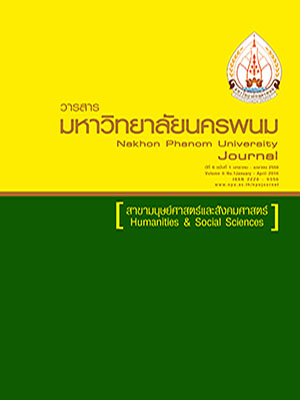A Study of the Marketing Channels of Ban Klang’s Layer Chicken Feeders’ Cooperative in Nakhon Phanom Province
Main Article Content
Abstract
การวิจัยครั้งนี้มีวัตถุประสงค์เพื่อศึกษาช่องทางการตลาดของกลุ่มสหกรณ์ผู้เลี้ยงไก่ไข่บ้านกลาง ตำบลบ้านกลาง อำเภอเมืองจังหวัดนครพนม โดยใช้วิธีการวิจัยเชิงสำ รวจและเชิงคุณภาพ ซึ่งทำการสัมภาษณ์และสังเกตการณ์ประชากรที่เป็นเกษตรกรทั้งหมดจำนวน 48 ราย (ร้อยละ 100) และทำการสุ่มตัวอย่างแบบโควตา (Quota Sampling) พ่อค้าส่งหรือผู้รวบรวม จำนวน 81 ราย แม่ค้าปลีกจำนวน 30 ราย และผู้บริโภค จำนวน 120 ราย โดยพิจารณาความโดดเด่นจากปัจจัยปริมาณไข่ไก่ที่จำหน่วย พื้นที่ในการจำหน่ายทั้งนี้สถิติที่วิเคราะห์ข้อมูล คือ จำ นวน (N) ผลรวม (ΣX) ร้อยละ (%) และค่าเฉลี่ย (x) เครื่องมือที่ใช้ในการเก็บรวบรวมข้อมูลเป็นแบบสอบถามมาตรส่วนประมาณค่า มีค่าอำนาจจำแนกระหว่าง 0.28-0.76 และมีค่าความเชื่อมั่นเท่ากับ 0.87ผลการวิจัยพบว่า มี 2 รูปแบบในการจัดจำหน่ายไข่ไก่ ได้แก่ รูปแบบที่ 1 มีการจำหน่ายภายในประเทศ 4 ช่องทาง คือ 1) ฟาร์ม ผู้รวบรวม พ่อค้าคนกลาง พ่อค้าปลีก และผู้บริโภค (ร้อยละ 51.98) 2) ฟาร์ม ผู้รวบรวม พ่อค้าปลีก และผู้บริโภค (ร้อยละ 26.73) 3) ฟาร์ม พ่อค้าปลีก และผู้บริโภค (ร้อยละ 17.13) 4) ฟาร์ม และผู้บริโภค (ร้อยละ 4.16) และรูปแบบที่ 2 มีการจำหน่ายภายในประเทศและต่างประเทศ 3 ช่องทาง คือ 1) ฟาร์ม ผู้รวบรวม พ่อค้าคนกลาง พ่อค้าปลีก และผู้บริโภค (ร้อยละ 39.83) 2) ฟาร์ม ผู้รวบรวม พ่อค้าปลีก และผู้บริโภค (ร้อยละ 32.61) 3) ฟาร์ม พ่อค้าปลีก และผู้บริโภค (ร้อยละ 27.56) รวมปริมาณผลผลิตไข่ไก่สำหรับเพื่อการบริโภคภายในจังหวัดนครพนมและจังหวัดใกล้เคียง และส่งออกไปยังสาธารณรัฐประชาธิปไตยประชาชนลาว จำนวน 29,362 ถาด/สัปดาห์ หรือ 125,837 ฟอง/วัน หรือคิดเป็นมูลค่า 304,970 บาท/วัน ซึ่งคิดเป็นเงินทุนหมุนเวียนในบ้านกลาง 9,149,100 บาท/เดือน
The purpose of this study was to investigate marketing channels of the egg-laying chicken farmers’ cooperative in Ban Klang sub-district, Mueang Nakhon Phanom district, Nakhon Phanom province. Survey and qualitative research designs were used to conduct this study along with the interviews and observations. The population of all farmers was 48 (100%). The quota sampling was conducted and the samples obtained included 81 egg wholesalers or compilers, 30 retailers, and 120 egg consumers. The outstanding volume of the eggs sold and the areas in which they were distributed were the criteria of the consideration for selection of the sample. Statistics used to analyze data were frequency, percentage and mean. The instrument employed for collecting data was a rating scale questionnaire whose discrimination power values ranged between 0.28 and 0.76 and reliability coefficient of 0.87. The results of study revealed that egg distributing channels comprised 4 channels in pattern 1 and 3 channels in pattern 2. The 4 channels of pattern 1 for domestic distributions were: channel 1 – by farmers, compilers, middlemen, retailers and consumers (51.98%), channel 2 – by farmers, compilers, retailers and consumers (26.73%), channel 3 – by farmers, retailers and consumers (17.13%), and channel 4 – by farmers and consumers (4.16%). Pattern 2 had 3 channels in domestic and foreign distribution of eggs: channel 1 – by farmers, compilers, middlemen, retailers and consumers (39.83%), channel 2 – by farmers, compliers, retailers and consumers (32.61%) and channel 3 – farmers, retailers and consumers (27.56%). The total amount of yielded eggs for consumption within Nakhon Phanom province and neighboring provinces including those exported to Lao People’s Democratic Republic was 29,362 trays with 30 eggs for each tray or 125,837 eggs per day which were worth 304,970 baht per day. This was the working capital in Ban Klang village which earned 9,149,100 baht


